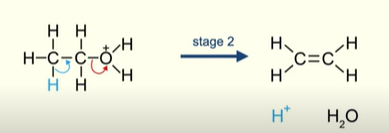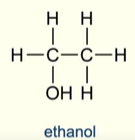Alcohols
1/22
There's no tags or description
Looks like no tags are added yet.
Name | Mastery | Learn | Test | Matching | Spaced |
|---|
No study sessions yet.
23 Terms
How are alcohols are produced?
Produced industrially by hydration of alkenes in the presence of an acid catalyst
How is ethanol produced and what’s the formula?
By the fermentation of glucose
Glucose→Ethanol+Carbon dioxide
C6H12O6 → C2H5OH+CO2
How can ethanol produced by fermentation be seperated?
Fraction distillation
When the ethanol is separated what can it be used as?
Biofuel
Define biofuel
A fuel derived from organic matter like plants
Can be considered a renewable source of energy
What are the conditions needed for fermentation?
Temperatures around 30-40 degrees
Yeast (which produces an enzyme)
No air (presence of oxygen would lead to aerobic respiration instead of fermentation)
Explain why the optimum temperature for fermentation is 38 degrees
At lower temperatures the reaction is too slow
At high temperatures the enzymes will denature
Why is fermentation done in the absence of air
Oxygen can oxidise the ethanol
producing ethanoic acid (Vinegar) instead
Advantages of fermentation
Sugar (glucose) is a renewable source
Production uses cheap equipment
Disadvantages of fermentation
Uses up land that could be used for food
Batch process is slow and raises production costs
Ethanol made is not pure and needs purifying by fractional distillation
Why is a batch process used in fermentation?
Allows for a high ethanol yield
Fermentation stops when ethanol concentration becomes toxic to yeast
Batch process ensures fermentation occurs for an optimal time before the yeast becomes inactive
Define the term carbon neutral
An activity that has no net carbon emissions to the atmosphere
Why is the production of ethanol considered carbon neutral
Its a biofuel formed from fermentation
Any carbon dioxide given off when the biofuel is burned would have been extracted from the air via photosynthesis by the plants grown
Meaning there is no net carbon emission
Equations showing that the production of ethanol is carbon neutral
Removal of CO2 by photosynthesis
6CO2 + 6H2O → C6H12O6 + 6o2
Production of CO2 by fermentation and combustion
C6H1206 → C2H5OH + 2CO2 (fermentation)
C2H5OH + 6O2 → 4CO2 + 6H2O (Combustion)
For every 6 molecules of carbon dioxide absorbed, 6 molecules of carbon dioxide are emitted
Why may the production of ethanol not be considered carbon neutral?
The equations that show it being a carbon neutral process do not take into consideration
Energy required to fractionally distil the ethanol
Energy required to irrigate( water) the plants.- Water pumps are powered by fossil fuels
What does dehydrating an alcohol do?
Removes a water molecule to form an alkene and water
Conditions for dehydration
Alcohol is heated under reflux (heating a reaction without losing the volatile substances)
Heated in the presence of concentrated sulfuric acid or phosphoric (v) acid
Acid act as a catalyst
Dehydration of alcohols is an example of an…
Elimination reaction
Products of dehydration of alcohols
Alkene
H2o
First stage of dehydration of alcohols
Lone pair of electrons on oxygen atom will be attracted to the positive hydrogen ion from the acid catalyst
Lone pair forms a covalent bond with the hydrogen ion
Forming an intermediate molecule with a positive oxygen atom

Second stage of dehydration of alcohols
Pair of electrons in the covalent bond between the C-O move onto the oxygen
This releases the molecule of water to be released
At the same time the pair of electrons between a C-H bond move between 2 carbon atoms
Hydrogen is now released as H+ (regenerating the acid catalyst

What can alkenes produced from dehydration of alcohols be used for ?
used to produce addition polymers (without using monomers derived from crude oil)
Describe a primary alcohol
Carbon atom bonded to the hydroxyl group (OH) is bonded to one more carbon atom
